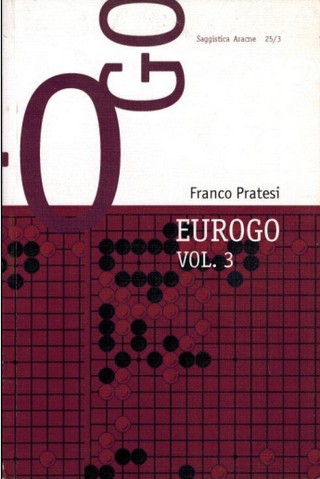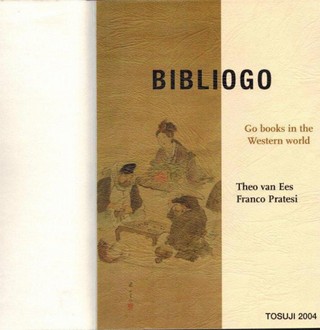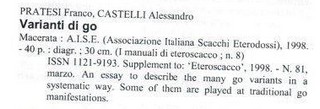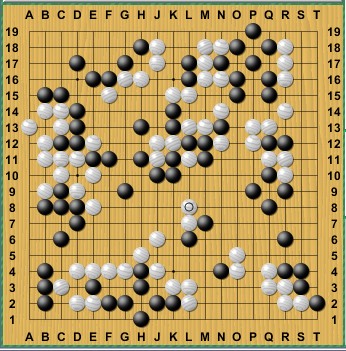EUROGO, Vol. 2, excerpt from Section 3-1 (pages 13-20)
Remains of Previous Go Organizations
Europe had much to suffer from WW2, and new political situations developed afterwards. A reasonable unification of the continent however took place slowly. Europe could enjoy
the benefit of a long peace, but this did not involve all its countries.
Moreover, in most cases, the battles of WW2 were followed by the cold war and only a few countries kept a complete neutrality between the two world blocks. Here, we are interested in the history of Go and of the general social and political history of Europe we only must describe the background, and only where and when it could significantly influence the progress of Go.
For instance, Spain and Portugal still kept for years governments of a nationalist kind, but this hardly interested the history of Go, because Go players practically did not yet exist in these – and in many other! – European countries.
As a consequence, we have now shortly to outline the political situation after WW2, not in the whole of Europe, but just in those countries and towns, where Go had flourished before the war. In this approach, we have thus to deal with what occurred to the losing part of the participants in the war, the Third Reich. Most European places of interest for Go history had belonged to the Third Reich, and after its dissolution they were scattered in several “new” countries.
Before entering our subject of the organization of Go, its associations, the most remarkable meetings, and so on, it seems unavoidable to remind some general “background” events and situations, which certainly had influence on the history of Go, directly or indirectly.
Let us thus extract the necessary information from the Columbia Encyclopedia1. As mentioned above, only places will be reviewed that are the more relevant, from the Go point of view. The time examined extends to about 1968, thus including the next section too.
Post-War Germany
The agreements of the Yalta Conference (Feb., 1945) were followed by an unconditional surrender to the Allies (May 7-8, 1945), and the Potsdam Conference (July-Aug., 1945). What remained of Germany was divided into four zones, occupied separately by the armies of Great Britain, France, the United States, and the USSR.
Berlin, similarly divided although situated well within the Soviet zone, was made the seat of the four-power Allied Control Council, authorized to make economic and administrative decisions for Germany as a whole. However, the council failed to agree and separate governments were soon established in each of the four zones.
In the Soviet zone, a military administration was established. In 1946, politics were brought under the control of the Communist-dominated Socialist Unity party (SED). At the same time, a major program of nationalization and collectivization was carried out. As reparations, the Soviets took much of E Germany’s industrial equipment for use in rebuilding their own industry.
The situation in W Germany was different, in spite of the arrival of about 10 million ethnic German refugees from the Soviet zone and the former German territories of E central Europe. Industrial machinery was restored to use, restrictions against the German cartels went largely unenforced, and West Germany’s remarkable recovery and reindustrialization soon began. The rebuilding process was facilitated by the Marshall Plan.
By 1947, the Western occupation zones were increasingly coordinating their policies (especially in economics), whereas Germany and Austria the Soviet zone followed an increasingly divergent policy. The split between the three Western Allies and the USSR became complete in 1948, when the Soviet authorities unsuccessfully blockaded West Berlin as part of the cold war.
In 1949, Germany was divided into the Federal Republic of Germany (West Germany) and the German Democratic Republic (East Germany). The precise legal status of West Berlin remained unclear; however, West Berlin was intimately tied to West Germany in many ways.
Go Life and Organization
Existing evidence and the opinions of some contemporary players seem to confirm that most of the programs of the Nazi organizations supporting Go activity were not as effective as they looked on paper. Indeed, few traces of Go teaching in the Third Reich can be found later on among German Go players, and obviously even less in other countries.
However, a distinction must be done between the environment of the Go players in general, and the leaders of the Go activities, and especially the Berlin group of strong players and organizers. Now, let us deal with common players, then we will separately discuss about the Berlin Go group.
Traces left by the Deutscher Go-Bund and the Deutsches Go-Institut
We have seen in a previous section that the DGoB and the DGoI were assisted by the Nazi organizations, and were certainly directed in agreement with the spirit of the Third Reich, in particular with the atmosphere of the Kraft durch Freude movement. This was true both for the leadership and for the supporters.
This situation had several advantages before and during the war, but it obviously was of no help after the war. On the contrary, it now became impossible even to think of reopening the Institut or even the former Go organization.
It can be acknowledged that at the end of the Thirties and beginning of the Forties, both DGoB and DGoI brought out strong increase in Go development. Most specific details have 16 Section 3 - 1 been completely lost or forgotten, but apparently these institutions were able to establish the basis for even greater progress.
In particular, if one considers the birth, management, and significance of the Go Institut, it could not have been established without Blachetta. The idea of a great centre for Go diffusion did not however die with the DGoI.
The Berlin Go Club was officially founded in 1953 with Felix Dueball as the leading player. For personal and political reasons it was impossible to re-establish Blachetta’s Institut. In 1954, a Go-Institut was associated with the DGoB, with its main aim being to represent the interface between Go and the media, and with Dr. Loewa as its first director. In 1959 it was again opened in the premises of the Japanese Embassy.
The New German Go Players
We have seen that the number of subscribers to the DGoZ increased substantially as soon as the game of Go became supported by the mass organizations of the Third Reich.
The new players recorded by Rüger were probably only a fraction of those who learnt the game in the Go courses. It is impossible to give a reliable estimate of all the German players in the last months of the war, but they may have been many more than those recorded by the DGoZ (the records from Berlin were destroyed with the DGoI).
Seen from later times, a large part of these new players disappeared after the war. We are not able to distinguish - in most cases - those among them who died in the last months of the war from those who, for any different reason (including the end of the Third Reich), chose never more to belong to a German association of Go players.
Of course, if a player had begun to play Go for political reasons, just because it was one of the forms of leisure suggested by the leaders of the Third Reich, he now had many reasons to forget about it.
On the other hand, it is possible that a large part of the “new” players that appeared after the war had initially learnt the basis of the game in some courses of the Third Reich having not subscribed to the DGoZ, and thus remaining undetected in our search).
The growth of German Go after the war was very slow. As a point of reference, we can mention a note3, essentially a table in three or four columns (date, who-where, remarks), in which Go players and events are listed in chronological order until 1976. An approximate evaluation is provided of the number of Go players - plotted against time for 1950-80 and showing a maximum at 1960-65, as well as recent estimated membership for various European countries.
The lists of German players of the 1950s, which can be found inserted in some issues of the DGoZ, appear however to be a logical continuation of Rüger’s lists. This is intended from a statistical point of view. Of course, several older players are not found there because they had fallen in the war!
In other words, there is no evidence for an increase of one or two orders of magnitude in the number of Go players, as one could have expected if most of the “new” players of the Third Reich had continued to play the game.
Go players continued to consist of small groups scattered in several towns. The old enthusiasts were there, with other players in their families, often in a new place whither they had moved after the war.
All evidence appears to confirm the opinion expressed by Ing. Friedrich Susan, who in Vienna had participated in all the developments of European Go since 1927 (his first subscription to the DGoZ) or earlier. His belief is that after the short interlude of the Third Reich, it was apparent that the driving force for the progress of Go had been Rüger and his activity, much more than all the Go events and organizations established by Blachetta.
On associations and federations one can be of different opinions. They fulfil their institutional goals as long as officers and members go on working for the service of the common interest. However, the situation becomes critical, when bureaucratism predominates, or association life is used by ambitious officers for their own interest.
We can find confirmation by examining a statistical study performed in 1965 by the German association on 235 Go players. The results are summarised in the picture.
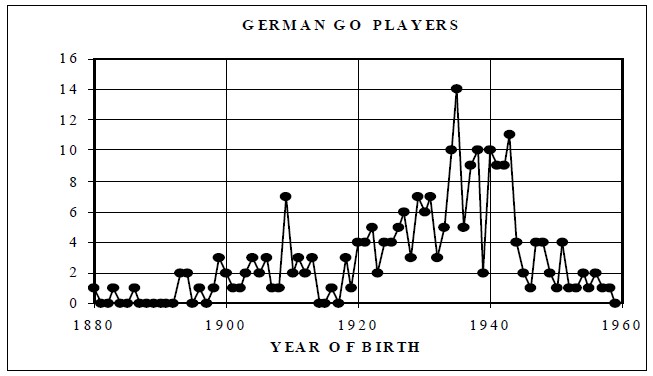
There are three old players, Dueball and Rüger brothers. Then a first gap can be explained, at least in part, with Go players fallen in WWI. A second gap corresponds to the considerable decrease in births near the end of WWI.
Obviously, the overall trend must fit both a slow general increase and the natural decrease of players at both limits of age.
Hundreds of players from the Go courses of the Third Reich are not visible. Not merely that: statistically, it seems that all the enterprises of Blachetta and his co-workers left practically no trace.
A different situation we will find with the Berlin Go leaders, most of them having previously joined forces with Blachetta himself.
Nuremberg - European Go Capital - New Go Journal and Association
Credit for bringing the Go players together again goes to Leonhard Grebe personally, and a couple of his initiatives. Leonhard Grebe (c1898-1975) was a musician by profession, but apparently he had also studied mathematics. Already in 1930 he had published a theoretical work on the mathematics of go.
Before the war, he lived in Jena and then took part in the Berlin activities. For instance, he participated in the 1938 Easter Go school in Schloss Elgersburg, with Fukuda as a
teacher, and in some of the annual Berlin congresses during the war. After WW2, like many other Germans living in the Eastern regions, he moved to the West and took up a new residence in
Nuremberg. From this town with its ancient traditions, he first provided European Go players with the addresses of all other known players.
First Lists of Go Players
Grebe had the very useful idea of compiling and distributing lists with the known addresses of Go players, especially in Germany and Austria, but also in other European countries, as soon as they became available.
The goal was to restablish once more a relationship between them, as there had been earlier, thanks to the activity of Bruno Rüger from Dresden, and of Walther Blachetta from Berlin. In March 1952 Grebe published in Nuremberg a first list of addresses of known Go players and distributed it, with the intention of following with enlarged lists approximately every month, including new entries received from readers.
His activity went farther, but this was the first post-war event that allowed contacts among Go players to be established again.
As a matter of fact, the community of Go players was so small and the atmosphere was so friendly that any Go player would in general be ready to welcome an unknown player, coming from anywhere.
However, the mobility of German people after the war was extremely high and it was not easy to have updated addresses, even those of old friends.
Thanks to Grebe, it was thus possible to resume old acquaintances
and to establish new ones. |

